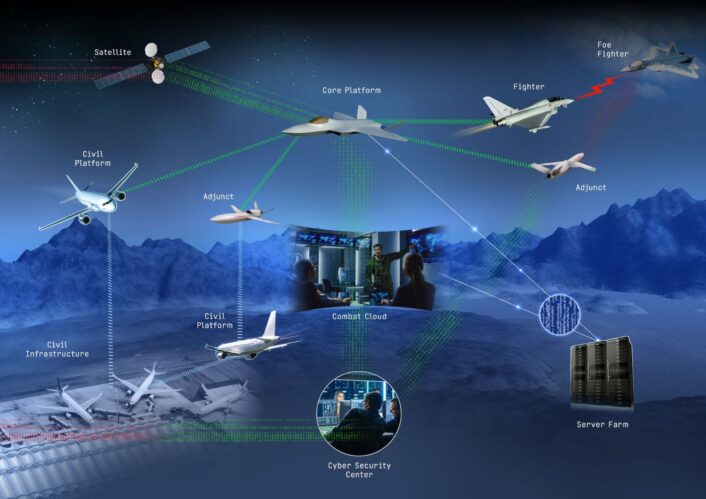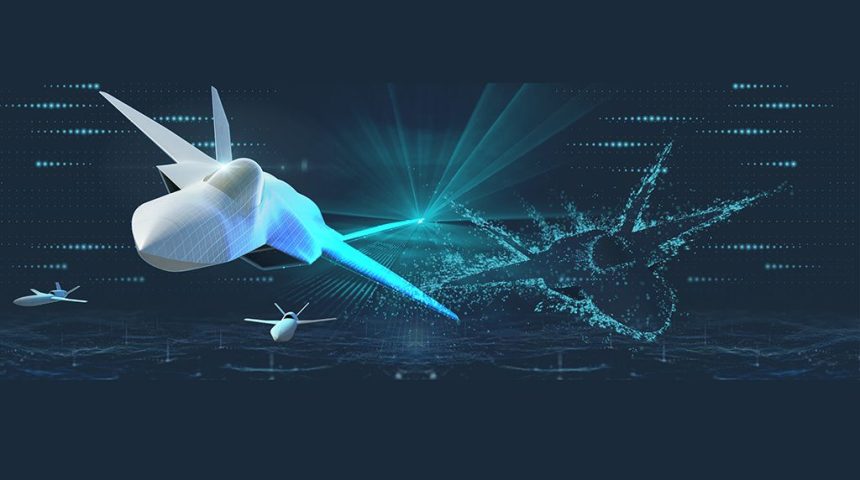UK says first demonstrator of Tempest 6th generation aircraft will fly in 5 years. Italy announces FCAS collaboration agreement.
FCAS took the center stage at Farnborough Airshow, that kicked off on Jul. 18, 2022, at Farnborough, UK. The beginning of the event, that is taking place after being cancelled in 2020 due to the pandemic, was indeed characterized by the updates provided by the governments of two of three nations involved in the development of the Future Combat Air System.
As we have often explained here at The Aviationist, the UK, Italy and Sweden signed a trilateral Future Combat Air System Cooperation Memorandum of Understanding on Dec. 21, 2020, which covers the cooperation for research, development and joint concepting of the FCAS. The programme is currently among the priorities of the three governments, which are now working to obtain a widespread industry participation to bring the best expertise to work on the project.
FCAS is a System of Systems (SoS) that includes next generation aircraft, UCAVs, and cyber capabilities. Most of the commentary and updates deal on just the 6th generation aircraft (also referred to as the “core plaftorm”) but FCAS combines multi-domain assets, that will cooperate in a MUM-T (Manned Unmanned Teaming) scenario and will be interconnected through a secure cloud network; technologies that are being designed today by the industry partners to meet the capability requirements of future conflicts and be operational in the mid-2030s.
While Italy and the UK plan to replace the current Eurofighter fleets with the 6th generation aircraft, Sweden seems to be more interested in the system as a whole rather than the “core platform”, considered the investments and effort put on the Gripen E.
On the Italian side, General Secretariat of Defense and National Armaments Directorate, in a press release said that “Italy and the UK have long been on a path to identify potential areas of industrial cooperation between leading national companies in the sector of Defense, with the ambition of initiating possible activities of mutual interest […and have now] reached a collaboration agreement within the Future Combat Air System (FCAS) program.”
“In this regard, Leonardo and BAE Systems have agreed to collaborate on the FCAS program. The companies of the two countries will identify shared areas of collaboration performing joint analysis on activities of mutual interest. In the same context Leonardo’s Italian and UK electronic businesses and Elettronica SpA are developing demonstration activities on advanced sensors and systems.”
According to the Italian MOD, “The collaboration between Leonardo and BAE Systems focuses on the application of Model Based System Engineering (MBSE) design methodologies and the joint development of enabling technologies for the national sovereignty of the future system. […] Furthermore, in line with this strategy, Leonardo’s Italian and UK electronic businesses and Elettronica SpA reached an agreement to collaborate in the sensors and communications area to support the technological development of the FCAS project. This initiative will deepen the established collaboration of these companies at the international level through a demonstration activity.”

Dealing with the British side, a press statement released by BAE Systems says that the UK Secretary of State for Defence, Ben Wallace MP has confirmed plans for Britain to lead the development of a new flying combat air demonstrator, with a first flying combat air demonstrator of the Tempest – designed and developed in the UK – slated to carry out the first flight in the next five years and a targeted induction into service in 2035.
“I am delighted that the UK, alongside Italy and Japan are working on similar combat air journeys together. Our work with Japan and Italy on cutting-edge technology like this shows the benefit of our alliances across the world”, Defence Secretary Ben Wallace said. Indeed, discussions about the possible participation of Japan in the program, after assessing the overlapping requirements and capabilities of the Tempest and the Japanese F-X, would be underway.
For what concerns the demonstrator, according to BAE Systems, “it will provide evidence for the critical technologies, methods and tools, which will be used on the core platform. As part of the broader activity involved in developing Tempest, the demonstrator programme is also helping retain, further develop and stimulate the next generation of skills and expertise required to deliver this ambitious programme.”
Interestingly, a new Tempest concept model was on display at Farnborough.
Better view of the backend…looking like a delta winged, tailless F-22… pic.twitter.com/KXru0Gc91O
— Tony Osborne (@Rotorfocus) July 18, 2022
The new design appears to be quite different from the previous one: it shows different nose section and intakes (now quite similar to the one of the F-22 Raptor) engine nozzles and general planform.
Anyway, as reported in the past, the Tempest will embed Artificial Intelligence, machine learning and autonomous systems that will pioneer human-AI teaming, a new Multi-Function Radar Frequency System technology that will reportedly collect and process 10,000 times more data than existing systems, as well as a revolutionary “wearable cockpit” powered by Augmented and Virtual Reality systems projected inside the pilot’s helmet. Leonardo is already working on an embryonic 6th gen. cockpit as part of a compact flight simulator called “Smart Chair”. The latter features VR, Eye Tracking and AI and gives the pilot an immersive experience, providing a 360°, 3D interactive environment. We had a chance to test it at Farnborough and here below you can find a brief video:
View this post on Instagram









